In the realm of crushing equipment, two key players stand out: the jaw crusher and the cone crusher. Both are essential for various crushing applications in industries such as mining, construction, and recycling. While they serve the same fundamental purpose of reducing large rocks into smaller particles, their designs, operating principles, and applications differ significantly. This essay aims to elucidate the variances between jaw crushers and cone crushers, shedding light on their distinct characteristics, advantages, and disadvantages.

Structural Design:
Jaw Crusher:
Structure: Jaw crushers consist of a fixed jaw and a movable jaw, mounted in a V shape.
Movement: The movable jaw reciprocates along a predetermined path, exerting force on the rock to break it down.
Design Features: Robust construction suitable for handling tough materials, but limited to coarse and medium crushing operations.
Cone Crusher:
Structure: Cone crushers feature a conical-shaped mantle and a concave bowl liner.
Movement: The mantle gyrates within the bowl, crushing the material against the concave liner.
Design Features: Ideal for fine and ultra-fine crushing applications due to its ability to produce uniform particle sizes.
Crushing Mechanism:
Jaw Crusher:
Crushing Mechanism: Compression is the primary crushing mechanism, where the material is squeezed between the two jaws.
Advantages: Suitable for hard and abrasive materials, high reduction ratios, simple structure.
Disadvantages: Limited capacity, less uniform product size compared to cone crushers.
Cone Crusher:
Crushing Mechanism: Compression and impact are the primary crushing mechanisms, where the material is repeatedly compressed and fragmented by the mantle and concave.
Advantages: High capacity, uniform particle size distribution, efficient crushing of softer materials.
Disadvantages: Higher maintenance requirements, complex structure compared to jaw crushers.
Application Range:
Jaw Crusher:
Applications: Primary crushing of hard and abrasive materials such as granite, basalt, and ores.
Common Industries: Mining, quarrying, construction.
Cone Crusher:
Applications: Secondary and tertiary crushing of various materials, including softer rocks and minerals.
Common Industries: Aggregate production, construction, metallurgy.
Operating Cost and Maintenance:
Jaw Crusher:
Operating Cost: Generally lower operating cost due to simpler mechanism and fewer moving parts.
Maintenance: Relatively straightforward maintenance, with periodic replacement of wear parts such as jaw plates.
Cone Crusher:
Operating Cost: Higher operating cost due to more complex structure and higher energy consumption.
Maintenance: Requires regular inspection and maintenance of components such as the mantle, concave, and hydraulic system.
In conclusion, while both jaw crushers and cone crushers serve as vital components in the crushing process, they exhibit distinct characteristics in terms of design, operating principles, and applications. Jaw crushers excel in handling hard and abrasive materials with high reduction ratios, while cone crushers are preferred for fine and ultra-fine crushing applications. Understanding these differences is crucial for selecting the most suitable crushing equipment for specific industry requirements, ensuring optimal performance and efficiency.

